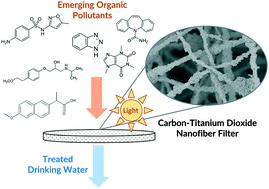当前位置:
X-MOL 学术
›
Environ. Sci.: Nano
›
论文详情
Our official English website, www.x-mol.net, welcomes your
feedback! (Note: you will need to create a separate account there.)
Carbon–titanium dioxide (C/TiO2) nanofiber composites for chemical oxidation of emerging organic contaminants in reactive filtration applications
Environmental Science: Nano ( IF 5.8 ) Pub Date : 2021-2-8 , DOI: 10.1039/d0en00975j Katherine E. Greenstein 1, 2, 3, 4 , Matthew R. Nagorzanski 1, 2, 3, 4 , Bailey Kelsay 1, 2, 3, 4 , Edgard M. Verdugo 1, 2, 3, 4 , Nosang V. Myung 4, 5, 6 , Gene F. Parkin 1, 2, 3, 4 , David M. Cwiertny 1, 2, 3, 4, 7
Environmental Science: Nano ( IF 5.8 ) Pub Date : 2021-2-8 , DOI: 10.1039/d0en00975j Katherine E. Greenstein 1, 2, 3, 4 , Matthew R. Nagorzanski 1, 2, 3, 4 , Bailey Kelsay 1, 2, 3, 4 , Edgard M. Verdugo 1, 2, 3, 4 , Nosang V. Myung 4, 5, 6 , Gene F. Parkin 1, 2, 3, 4 , David M. Cwiertny 1, 2, 3, 4, 7
Affiliation

|
The recalcitrance of some emerging organic contaminants through conventional water treatment systems may necessitate advanced technologies that use highly reactive, non-specific hydroxyl radicals. Here, polyacrylonitrile (PAN) nanofibers with embedded titanium dioxide (TiO2) nanoparticles were synthesized via electrospinning and subsequently carbonized to produce mechanically stable carbon/TiO2 (C/TiO2) nanofiber composite filters. Nanofiber composites were optimized for reactivity in flow through treatment systems by varying their mass loading of TiO2, adding phthalic acid (PTA) as a dispersing agent for nanoparticles in electrospinning sol gels, comparing different types of commercially available TiO2 nanoparticles (Aeroxide® P25 and 5 nm anatase nanoparticles) and through functionalization with gold (Au/TiO2) as a co-catalyst. High bulk and surface TiO2 concentrations correspond with enhanced nanofiber reactivity, while PTA as a dispersant makes it possible to fabricate materials at very high P25 loadings (∼80% wt%). The optimal composite formulation (50 wt% P25 with 2.5 wt% PTA) combining high reactivity and material stability was then tested across a range of variables relevant to filtration applications including filter thickness (300–1800 μm), permeate flux (from 540–2700 L m−2 h), incident light energy (UV-254 and simulated sunlight), flow configuration (dead-end and cross-flow filtration), presence of potentially interfering co-solutes (dissolved organic matter and carbonate alkalinity), and across a suite of eight organic micropollutants (atrazine, benzotriazole, caffeine, carbamazepine, DEET, metoprolol, naproxen, and sulfamethoxazole). During cross-flow recirculation under UV-irradiation, 300 μm thick filters (30 mg total mass) produced micropollutant half-lives ∼45 min, with 40–90% removal (from an initial 0.5 μM concentration) in a single pass through the filter. The initial reaction rate coefficients of micropollutant transformation did not clearly correlate with reported second order rate coefficients for reaction with hydroxyl radical (kOH), implying that processes other than reaction with photogenerated hydroxyl radical (e.g., surface sorption) may control the overall rate of transformation. The materials developed herein represent a promising next-generation filtration technology that integrates photocatalytic activity in a robust platform for nanomaterial-enabled water treatment.
中文翻译:

碳-二氧化钛(C / TiO2)纳米纤维复合材料,用于化学氧化反应性过滤应用中新兴的有机污染物
通过常规水处理系统对某些新兴有机污染物的顽固抵抗可能需要使用具有高反应性,非特异性羟基的先进技术。在此,通过静电纺丝合成了嵌入了二氧化钛(TiO 2)纳米粒子的聚丙烯腈(PAN)纳米纤维,随后进行了碳化,以生产出机械稳定的碳/ TiO 2(C / TiO 2)纳米纤维复合过滤器。通过改变TiO 2的质量负载,添加邻苯二甲酸(PTA)作为静电纺丝溶胶凝胶中纳米颗粒的分散剂,优化了纳米纤维复合材料在处理系统中的反应性,比较了不同类型的市售TiO2个纳米颗粒(Aeroxide®P25和5 nm锐钛矿纳米颗粒),并通过金(Au / TiO 2)作为助催化剂进行官能化。高的体积和表面TiO 2浓度与增强的纳米纤维反应性相对应,而PTA作为分散剂则使得可以以非常高的P25含量(〜80%wt%)制造材料。然后在与过滤应用相关的一系列变量中测试了最佳的复合配方(50 wt%P25与2.5 wt%PTA)结合了高反应性和材料稳定性,包括过滤器厚度(300–1800μm),渗透通量(540–2700起) L m -2h),入射光能(UV-254和模拟日光),流量配置(死角和错流过滤),存在潜在干扰的共溶质(溶解的有机物和碳酸盐碱度),并且横跨八个有机微污染物(阿特拉津,苯并三唑,咖啡因,卡马西平,DEET,美托洛尔,萘普生和磺胺甲恶唑)。在紫外线辐射下的横流再循环过程中,300μm厚的过滤器(总质量30 mg)产生的微污染物半衰期约为45分钟,单次通过过滤器时去除率达40-90%(从最初的0.5μM浓度开始)。 。微污染物转化的初始反应速率系数与与羟基自由基(k OH),暗示与光生羟基自由基发生反应以外的其他过程(例如,表面吸附)可能会控制总转化率。本文开发的材料代表了一种有前途的下一代过滤技术,该技术将光催化活性整合到了用于纳米材料的水处理的强大平台中。
更新日期:2021-02-12
中文翻译:

碳-二氧化钛(C / TiO2)纳米纤维复合材料,用于化学氧化反应性过滤应用中新兴的有机污染物
通过常规水处理系统对某些新兴有机污染物的顽固抵抗可能需要使用具有高反应性,非特异性羟基的先进技术。在此,通过静电纺丝合成了嵌入了二氧化钛(TiO 2)纳米粒子的聚丙烯腈(PAN)纳米纤维,随后进行了碳化,以生产出机械稳定的碳/ TiO 2(C / TiO 2)纳米纤维复合过滤器。通过改变TiO 2的质量负载,添加邻苯二甲酸(PTA)作为静电纺丝溶胶凝胶中纳米颗粒的分散剂,优化了纳米纤维复合材料在处理系统中的反应性,比较了不同类型的市售TiO2个纳米颗粒(Aeroxide®P25和5 nm锐钛矿纳米颗粒),并通过金(Au / TiO 2)作为助催化剂进行官能化。高的体积和表面TiO 2浓度与增强的纳米纤维反应性相对应,而PTA作为分散剂则使得可以以非常高的P25含量(〜80%wt%)制造材料。然后在与过滤应用相关的一系列变量中测试了最佳的复合配方(50 wt%P25与2.5 wt%PTA)结合了高反应性和材料稳定性,包括过滤器厚度(300–1800μm),渗透通量(540–2700起) L m -2h),入射光能(UV-254和模拟日光),流量配置(死角和错流过滤),存在潜在干扰的共溶质(溶解的有机物和碳酸盐碱度),并且横跨八个有机微污染物(阿特拉津,苯并三唑,咖啡因,卡马西平,DEET,美托洛尔,萘普生和磺胺甲恶唑)。在紫外线辐射下的横流再循环过程中,300μm厚的过滤器(总质量30 mg)产生的微污染物半衰期约为45分钟,单次通过过滤器时去除率达40-90%(从最初的0.5μM浓度开始)。 。微污染物转化的初始反应速率系数与与羟基自由基(k OH),暗示与光生羟基自由基发生反应以外的其他过程(例如,表面吸附)可能会控制总转化率。本文开发的材料代表了一种有前途的下一代过滤技术,该技术将光催化活性整合到了用于纳米材料的水处理的强大平台中。











































 京公网安备 11010802027423号
京公网安备 11010802027423号